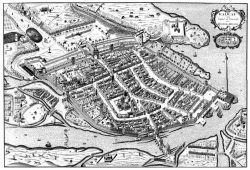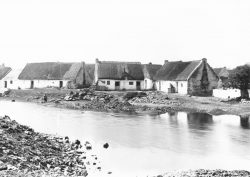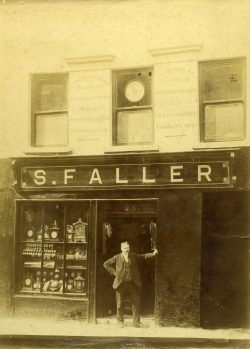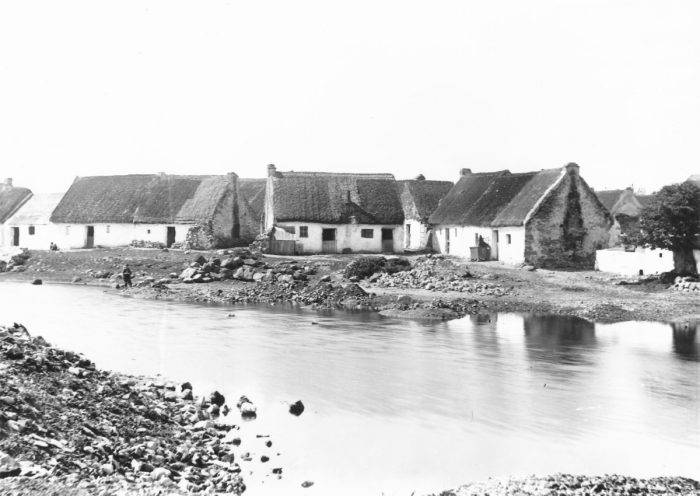The history of the Claddagh ring dates back some four hundred years. Richard Joyce a gold and silversmith from Galway is attributed with the original design of the Claddagh ring. While myths surround the true origins Richards account is one of the most historically accurate. Richard Joyce was an early 17thCentury Goldsmith born in Galway into one of the fourteen Tribes of Galway, Richard began his craft in Galway. During this period Galway was bustling port city, with close ties to France, Portugal and Spain the city was a hive of activity. The success of Galway was largely in part to the fourteen tribe families of Galway.

Galway was founded in 1124, when a castle erected by the Connacht men near the ancient fishing village known as Ballinshruane, or Streamstown. In 1228 Richard De Burgh defeated Hugh O’Flaherty and Galway became a Norman town. During the 14th, 15thand up to the middle of the 16thcentury it was virtually an independent city state. Subject directly to the King of England at the time. Galway was thriving port city said to be second only to London at the time.
There is history of Silver and Goldsmiths dating back in Galway from the 15thCentury. The reference is made in city by-law from 1500. Another example of the trade is found in the form of a grave slab dated 1641. This is located in St. Nicholas’ Church, Galway. The Church is one of Galway’s oldest structures dating back to the 15thCentury. St. Nicholas is the patron Saint of Sailors and Merchants, quite poignant with the main trade of the city back then.
The city was known worldwide for the craftsmanship and design in ecclesiastical ware and silver table ware. A young Richard Joyce would have trained under the Master Goldsmith of the City. Richard was adventures and wanted to gain experience in the wealthy West Indies. Richard set sail from the port of Galway in 1675. Shortly after setting sail Richards boat was captured and detained. Richard along with the crew were detained along the North African Barbary Coast. The fate of the young Galway goldsmith hung in the balance. It was said Richard engraved stone and wood to keep his skills, he was spotted by Wealthy merchant who acquired Richards skill.
The wealthy merchant at the time was said to be a jeweller. Richard began working and learning under the merchant acquiring the skill and craftsmanship associated with jewellery. In 1689 under the direct orders of King William III all subjects across the lands of the North African Coast were to be released immediately. Upon hearing the newest Joyce’s Master pleaded with Joyce to remain. Offering the family business and his daughters hand in marriage. Joyce declined the offer and returned to Galway.
It was upon his return Joyce established himself as one of Galway’s leading silver and goldsmith. Upon Joyce’s return he married and acquired the property of Colonel Whaley , the estate of Rahoon. As a member of the Galway ‘Tribes’ Joyce was in constant demand, with the Galway ‘Tribes’ gifting Chalices and silver ecclesiastical wear. Joyce began crafting the Claddagh ring and they were discovered to be of various Karat Gold, the ring became very popular with people from the Claddagh Ancient Fishing Village.

It was said the people of the ancient fishing village of Claddagh were so taken by the symbol it became their symbol of identifying the fishing fleet. Richard made many important Claddagh Rings and none more so than the “King Claddagh” Ring. As the ancient fishing village pre-dated Galway, the village was ruled by one key alderman, known as the “King of the Claddagh” the King oversaw important trades and traditions among the community.
The next reference to Richard Joyce is in the Hearth Money Roll of Galway 1724. Joyce is noted of payment of ten shillings, Richard Joyce, Shop Street. Much of Richards work can be viewed In the Galway City Museum whom have a collection of his work. Unfortunate due to economic depression, famine and mass emigration from Ireland very little of Joyce’s’ works remain. Many of his ecclesiastical works can be found on display such as The “James Hyde “ Chalice dated 1717, The “Hon. Thos. Burke” Chalice also dated 1717 and The Bodkin – Brown Chalice inscribed 1737, said to be the last known chalice stamped with the makers initials R.I and the Anchor to represent Galway. According to historical records Joyce had three daughters, one of whom married Bartholomew Fallon. Little else is known about the Silver and Goldsmith, it would show upon his death the Claddagh ring died along with Joyce. It was not revived until some 70 years later when George Robinson, the English goldsmith who settled in Galway. George Robinson registered his initials G.R with the Irish Assay office in 1784. Robinson altered the Karat weight of gold across these rings from 22K , 18k , 14K down to 8 Karat gold Claddagh rings. Much like the practice of Richard Joyce.
Other notable Galway Gold and Silversmiths include Mark Fallon , Thomas Lynch , Andrew Robinson , Austin French , Richard Shadwell and Nicholas Burdge. All these jewellers would have had their own style of Claddagh ring many putting their own unique twist in design and manufacturing of the Claddagh ring. Again due to years of hardship with the great famine in 1845 until 1851 many of these Claddagh rings were traded and scraped for monies to emigrate the Island during the darkest times. Some rings survived with accounts of Claddagh rings been found from New York down to Boston.

In 1879 upon opening his new jewellery and watch store in Galway , Stephen Faller noticed the Claddagh ring and it’s association to the people of Galway. Stephen began making Claddagh rings in the workshop above the store. Stephen began producing silver and gold Claddagh rings and gained a reputation for quality and craftsmanship. The initials S.F were registered with Dublin Assay office in Dublin, Castle. Today we are the oldest manufacturer of Galway Claddagh Rings in Galway and Ireland. Fallers jewellers of Galway are noted as makers of the Claddagh ring in Jackson’s English Goldsmiths and their Marks, published in 1921
Fallers jewellers have been commissioned by the Irish Government to manufacture and produce many Claddagh associated gifts to Freemen of the City. None more so than several gifts for the visit of United States President John Fitzgerald Kennedy in 1963. Fallers jewellers presented the President and his wife Jacky Kennedy two Claddagh Rings while on a visit to Galway in June 1963.
We are delighted to share with you the history behind the famous Claddagh ring, Call into our store on Williamsgate Street, Galway to see the largest collection of authentic Claddagh rings and jewelery. As makers of the Claddagh ring we have the largest collection of Claddagh Rings , Earrings , Bracelets and Pendants Made in Ireland. Click on the links above to view your favourite collection.










